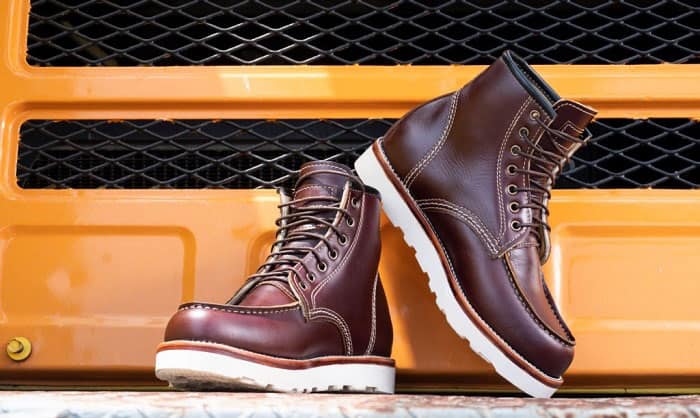There are so many safety shoes in the market right now that choosing the right pair has become a serious task, like choosing between wedge sole vs heel work boots.
But which should you choose between the two?
If comfort is what you’re after, then choose the wedge work boot because it provides better ease and comfort compared to heel work boots. Want to know why? Read along and learn other vital factors you need to consider when choosing one.
Table of Contents
What is a Wedge Sole Work Boot
A wedge sole work boot is a safety shoe whose main feature is the wedge outsoles. It is called a wedge sole because the toe region of the outsole is wide and it gets thicker toward the heel region, thus the wedge shape.
The use of wedge sole work boots benefits the people who spend most of their work time walking on tough flat surfaces, sitting or staying long in one area such as heavy equipment operators, drivers, farmers, electricians, welders, light-duty construction workers and carpenters.
What is a Heel Work Boot
A heel work boot is a common and popular design in the safety shoe industry. It is easy to spot a heeled work boot because it is known for its very defined heel, treads and deep lugs. The heel and front sole of the work boot are the only regions that are in touch with the ground because there is a gap in the middle part.
You should wear a heel work boot if you are working outdoors on uneven ground like in the logging or mining industries or if your work involves moving around constantly or climbing ladders, such as safety and security officers, linemen and firefighters.
Wedge vs Heel Work Boots: Tale of the Tape
Which has the better sole? Are wedge sole boots more comfortable? Are heel work boots more durable? Which between wedge vs heel work boots is more valuable? These are just some of the important questions you need to answer when getting a pair of safety work boots.
Which Has the Better Material?
Wedge: The outsole of this safety footwear is made from a piece of rubber that covers its entire base. It is commonly made from polyurethane rubber, a material that is a high-quality abrasion-resistant synthetic fiber. The wedge’s PU rubber sole material makes it waterproof, lightweight, and a good shock absorber.
Heel: The toe and heel regions of this safety boot are typically crafted using thick rubber or synthetic materials. It can protect against oil slips and have an abrasion-resistant feature. The thick material is proven to be wear-resistant, waterproof, and provides great stability.
And the winner is: You should go for the soles with thick rubber. Although the wedge heel work boots are made from quality materials, the thickness of the rubber material used in manufacturing the heel work boot makes it “the better” sole material for a safety boot.
Which is More Comfortable?
Wedge: One piece of polyurethane rubber is enough to cover the entire outsoles of wedge boots, and this allows the entire sole to touch the ground at every step. And because the sole is stretched from the front to the heel side of the shoes, the pressure you exert is distributed evenly across the boots.
Heel: The heel work boots have two regions, the heel and the toes and a gap in between. So every time you use them, the pressure of walking or running is heavily exerted to the toe and heel regions of your feet.
And the winner is: The more comfortable of the two is definitely the wedge sole work boots. The even distribution of pressure on the wedge soles is healthier for your feet because it helps in minimizing the strain you might feel from using a work boot for a long period.
Which Has the Better Grip?
Wedge: The polyurethane rubber sole of wedge work boots is designed with light treads, and although the treads are shallow, they have an oil-resistant function that helps in preventing trips and slips.
Heel: The outsole of a heel work boot is created with deep lugs and treads, which allow for a good grip and traction in all types of terrain.
And the winner is: The sole with the better grip is the heeled work boot. This work boot can be used in every type of work environment. The deep lugs and treads in the outsoles provide better grip compared to the shallow tread of wedge work boots.
Which is More Durable?
Wedge: The polyurethane rubber outsoles of this safety work boot is a high-quality synthetic material that is designed to be very durable, but because the sole is thin, and with constant use and dragging, it tends to deteriorate faster.
Heel: The outsoles of a heel work boot are very thick and sturdy. They are created and designed to provide you with a protective work boot that would last for a long time. The thickness of the soles is a good reason why heeled-work boots are considered to be very durable.
And the winner is: Although the two safety work shoes are created with quality materials to ensure that you can use them for a long period, the heeled safety footwear is the clear winner when it comes to durable work boots. You can use the heel work boot for a longer time compared to the wedge soled work boot.
Which Has the Better Value for Money?
Wedge: Because of the thin soles, there is a high chance that the boot is damaged faster, especially with constant use. As a result, a wedge sole might need to be repaired, or worse, you have to replace it.
Heel: The thick soles of the heel work boot warrant its sturdiness and longevity, so it doesn’t break easily and fast. Because of that, you don’t have to worry about spending money for repair or replacement for some time.
And the winner is: The current market price for both wedge and heel work shoes are generally the same; it varies only according to the brand, the size and the design.
If you are looking for a long-term value for money, then choose a heel work boot, because it is proven to be more sturdy and durable compared to wedge boots. With heel boots, you don’t have to spend additional money to repair or replace them sooner than the wedge boot.
The Better Sole
Clearly, the work boot with a heel sole is the better choice for safety shoes compared to wedge soled boots; it won 4 out of the 5 factors presented above. Meanwhile, here’s a link to a video discussing why you need to wear a heel soled work boot:
A heel work boot may be the better choice, but it doesn’t mean that you cannot own a wedge soled boot, because at the end of the day, it is still your choice and the advantages of wedge sole boots that you see may weigh more than the advantages of heeled-work boots.
Conclusion
For a long time, the use of safety shoes in hazardous workplaces has been mandatory for the protection of workers. Whatever you choose between the wedge sole vs heel work boots is entirely up to you because both provide foot protection.
What this article tries to emphasize is that you need to weigh the heel and wedge sole boots pros and cons first before buying, and the better choice according to the different factors we considered is the heel work boot. We also have some compared articles between boots’ brands such as Red Wing vs Wolverine work boots or Timberland pit boss vs titan. You can refer to them to understand more about work boots before buying them.

This is Edward Manning, the editor in chief of Construction Informer. Quite a bit of my time is spent researching the market and interviewing experts in the field so that I can give you reliable information.





